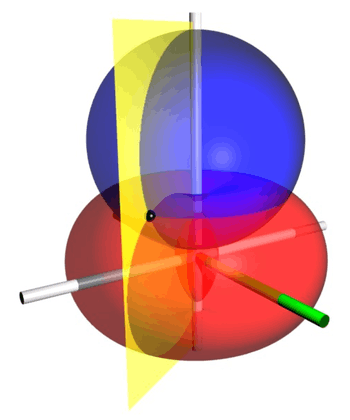Bispherical coordinates

Bispherical coordinates are a three-dimensional orthogonal coordinate system that results from rotating the two-dimensional bipolar coordinate system about the axis that connects the two foci. Thus, the two foci  and
and  in bipolar coordinates remain points (on the
in bipolar coordinates remain points (on the  -axis, the axis of rotation) in the bispherical coordinate system.
-axis, the axis of rotation) in the bispherical coordinate system.
Definition
The most common definition of bispherical coordinates  is
is
where the  coordinate of a point
coordinate of a point  equals the angle
equals the angle  and the
and the  coordinate equals the natural logarithm of the ratio of the distances
coordinate equals the natural logarithm of the ratio of the distances  and
and  to the foci
to the foci
Coordinate surfaces
Surfaces of constant  correspond to intersecting tori of different radii
correspond to intersecting tori of different radii
that all pass through the foci but are not concentric. The surfaces of constant  are non-intersecting spheres of different radii
are non-intersecting spheres of different radii
that surround the foci. The centers of the constant- spheres lie along the
spheres lie along the  -axis, whereas the constant-
-axis, whereas the constant- tori are centered in the
tori are centered in the  plane.
plane.
Inverse formulae
The formulae for the inverse transformation are:
where  and
and 
Scale factors
The scale factors for the bispherical coordinates  and
and  are equal
are equal
whereas the azimuthal scale factor equals
Thus, the infinitesimal volume element equals
and the Laplacian is given by
Other differential operators such as  and
and  can be expressed in the coordinates
can be expressed in the coordinates  by substituting the scale factors into the general formulae found in orthogonal coordinates.
by substituting the scale factors into the general formulae found in orthogonal coordinates.
Applications
The classic applications of bispherical coordinates are in solving partial differential equations, e.g., Laplace's equation, for which bispherical coordinates allow a separation of variables. However, the Helmholtz equation is not separable in bispherical coordinates. A typical example would be the electric field surrounding two conducting spheres of different radii.
Bibliography
- Morse PM, Feshbach H (1953). Methods of Theoretical Physics, Part I. New York: McGraw-Hill. pp. 665–666.
- Korn GA, Korn TM (1961). Mathematical Handbook for Scientists and Engineers. New York: McGraw-Hill. p. 182. LCCN 59014456.
- Zwillinger D (1992). Handbook of Integration. Boston, MA: Jones and Bartlett. p. 113. ISBN 0-86720-293-9.
- Moon PH, Spencer DE (1988). "Bispherical Coordinates (η, θ, ψ)". Field Theory Handbook, Including Coordinate Systems, Differential Equations, and Their Solutions (corrected 2nd ed., 3rd print ed.). New York: Springer Verlag. pp. 110–112 (Section IV, E4Rx). ISBN 0-387-02732-7.
External links
| ||||||||||












![\begin{align}
\nabla^2 \Phi =
\frac{\left( \cosh \tau - \cos\sigma \right)^3}{a^2 \sin \sigma}
& \left[
\frac{\partial}{\partial \sigma}
\left( \frac{\sin \sigma}{\cosh \tau - \cos\sigma}
\frac{\partial \Phi}{\partial \sigma}
\right) \right. \\[8pt]
&{} \quad + \left.
\sin \sigma \frac{\partial}{\partial \tau}
\left( \frac{1}{\cosh \tau - \cos\sigma}
\frac{\partial \Phi}{\partial \tau}
\right) +
\frac{1}{\sin \sigma \left( \cosh \tau - \cos\sigma \right)}
\frac{\partial^2 \Phi}{\partial \phi^2}
\right]
\end{align}](../I/m/1f527807e184dd9f6ee0e9cf4a6f21fb.png)